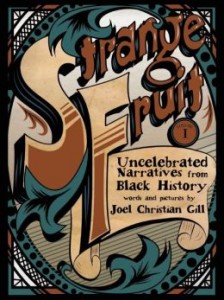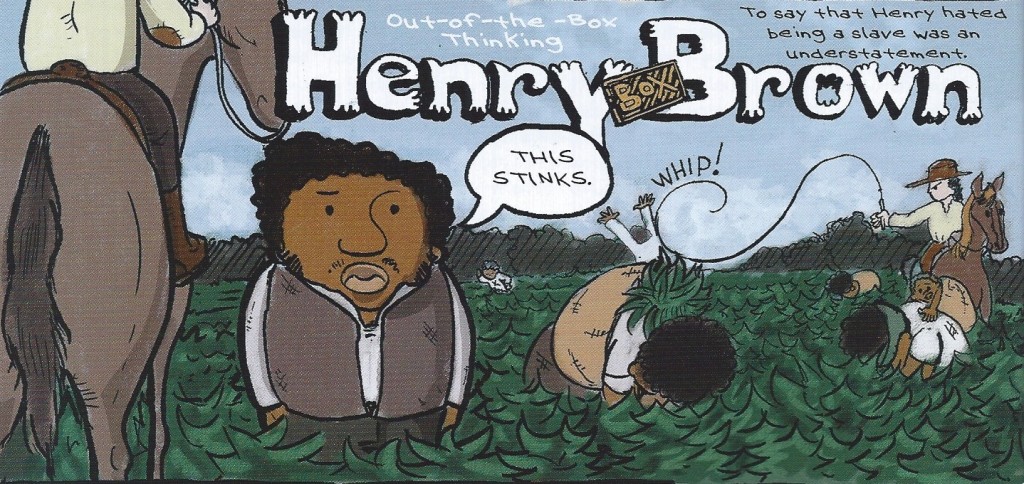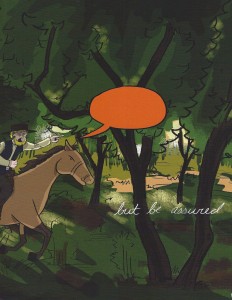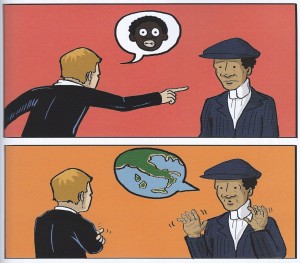My copy of Joel Christian Gill’s new graphic novel arrived in the mail last week shortly after I read Frank Bramlett’s post on the way editorial comics depict Michael Sam, the openly gay, black football player who was recently drafted by the NFL’s St. Louis Rams. Of particular interest to Frank was how few of the comics he found rely on metaphor to convey meaning and instead invoke more literal representations of Sam to comment upon the significance (or insignificance) of his social identity. As the post makes clear, scrutinizing the visual and verbal shorthand that comics use to illustrate abstract ideas like race or sexual orientation can reveal a great deal about how society negotiates changing attitudes, institutions, and avenues of power.
Gill’s collection, Strange Fruit: Uncelebrated Narrative from Black History, provides us with another opportunity to raise questions about the figurative modes of expression that today’s comics creators use to represent race and racism. Readers of the short stories in Strange Fruit quickly learn to appreciate the playful succinctness of Gill’s iconographic language. He knows when to use humor and sight gags to advance the story. (On the experience of enslavement, Henry “Box” Brown remarks: “This stinks.”) But Gill knows when more serious cultural cues are needed too, as in the two-page spread where Brown’s body, shown curled inside a wooden box, silently tumbles from slavery to freedom.
Yet in the graphic novel’s accounts of lesser known African American figures and infamous historical events, Gill’s depiction of race hatred also caught my attention. When angry whites confront African Americans in these stories, their speech is represented as orange or red word balloons that contain no printed text. It isn’t difficult to imagine what is being said in these exchanges. But perhaps that is the point.
In other instances, the verbal threats and insults of whites are condensed into a single image of a black caricatured face with wide saucer eyes and swollen lips. The panel below is from a stunning story called “The Shame” about the denigration and forcible eviction of the black residents from Malaga Island off the coast of Maine in 1912. In the exchange, a former Malaga resident is attempting to “pass” and conceal his black identity.
Exactly what is being said here? Can the sentiments expressed in the top panel alone ever fully be translated into printed text? Gill’s arrangement of the well-known visual racial caricature seems to go beyond words to convey a culturally and historically situated discursive practice. The pictographic balloon draws our attention to the constructedness of an image meant to articulate a host of ideas about black inferiority. (The accused responds with a fiction of his own by attributing his physical features to an Italian lineage.) I also think it’s fitting that this exchange appears in a story that takes place during the early 20th century when caricatures dominated visual representations of blacks and other ethnic groups. In his efforts to retrieve the neglected history of African Americans, Gill arguably makes those early cartoonists complicit in his critique of racism as well.
Strange Fruit goes a step further in completely depersonalizing white supremacist ideology by representing angry white people literally as (jim) crows. In stories like “The Noyes Academy” about the destruction of the nation’s first integrated school or “The Black Cyclone” about one of the fastest black cyclists in the world, outraged whites are transformed into belligerent red-eyed birds that chase and poke their wings into black faces. They speak only in blank word balloons, pictograms, and the occasional “caw!”
Relying on these kinds of visual metaphors is not without risk, but I believe that Gill’s comic succeeds in redirecting the reader’s attention to the voices that matter most to him, that of Henry “Box” Brown, Harry “Bucky” Lew, Richard Potter, Theophilus Thompson, Alexander Crummell, Marshall “Major” Taylor, Spottswood Rice, and Bass Reeves — men who despite their different circumstances, encountered racism’s vitriolic squawk in comparable ways. Black resistance and agency remain key elements in every incident chronicled in Strange Fruit, even for the stories that end in tragedy (these are the uncelebrated, after all). Let’s hope we’ll see more narratives of uncelebrated black women in volume two.
Last month, World War Z writer Max Brooks and artist Caanan White published, The Harlem Hellfighters, a graphic novel about an all-black infantry unit during World War I. It shares with Strange Fruit an interest in recovering details about African American life and culture that have been overlooked (and both are helpfully endorsed by Henry Louis Gates, Jr.). But in contrast to the more conventional heroic narrative and mimetic style of The Harlem Hellfighters, I think that Gill’s experimental choices result in stories that are not just aesthetically richer, but that also illustrate a wider range of interpretive possibilities for remembering the past.
The way in which Gill represents racist speech in Strange Fruit is just one example of these artistic choices. What do you think about his strategy? I’d be interested to hear if you’ve seen similar approaches in other comics too.





